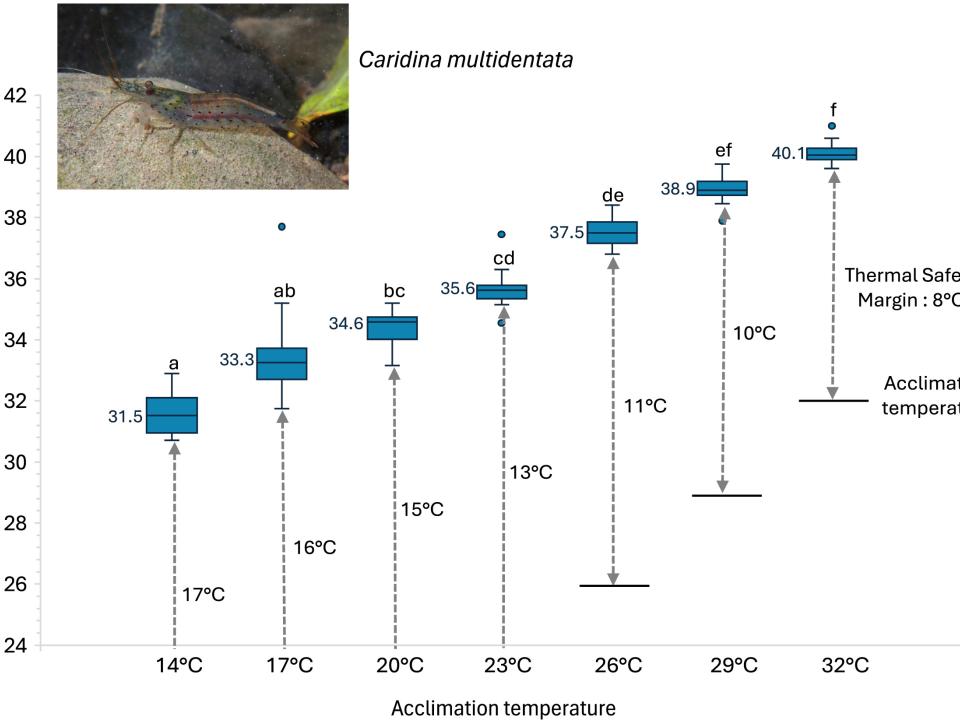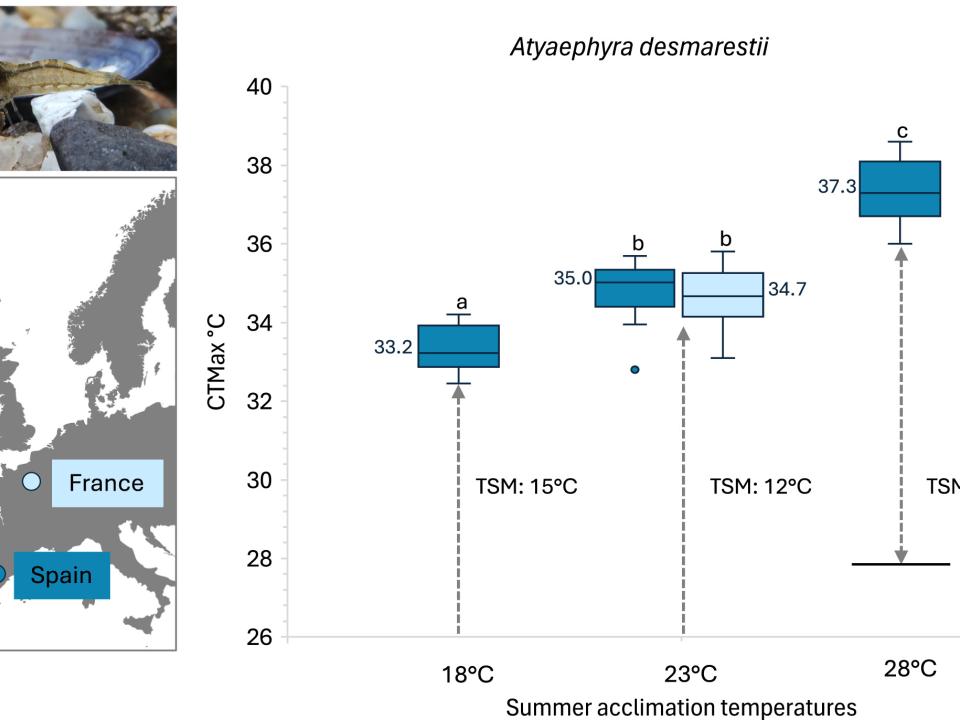Ravaux, J., Bosc, O., Fusari, C.-E., Gricourt, S.-M., Itin, M., Lestin, M., & de Mazancourt, V. (2025). Thermal tolerance and vulnerability to climate warming in the freshwater shrimp Atyaephyra desmarestii and Caridina multidentata. Journal of Thermal Biology, 129, 104121. https://doi.org/10.1016/J.JTHERBIO.2025.104121
Les crevettes d'eau douce jouent un rôle crucial dans les écosystèmes aquatiques, mais leur vulnérabilité au changement climatique reste mal comprise. Cette étude porte sur la tolérance thermique et la vulnérabilité au réchauffement climatique de deux importantes espèces de crevettes d'eau douce aux préférences écologiques contrastées, Atyaephyra desmarestii et Caridina multidentata. La limite de tolérance thermique maximale (CTMax) a été évaluée pour différentes températures d'acclimatation qui couvrent la gamme estivale actuelle des deux espèces, ainsi que pour des populations d'origines géographiques différentes pour A. desmarestii. Les deux espèces ont démontré un excès de tolérance thermique dans toutes les conditions, comme calculé avec les marges de sécurité thermique (TSM). Cependant, la diminution de la marge de sécurité thermique avec l'augmentation des températures d'acclimatation suggère des limites potentielles dans leur capacité à faire face au réchauffement futur, en particulier pour les populations méridionales d'A. desmarestii. En outre, bien que C. multidentata ait fait preuve d'une grande tolérance aux fluctuations extrêmes de température, elle pourrait être confrontée à des difficultés pour maintenir des populations viables dans le cadre des scénarios de changement climatique prévus.
La présente étude fournit également un aperçu des limites thermiques des Caridea, soulignant ainsi la nécessité de poursuivre les recherches sur la tolérance thermique des crevettes afin d'élaborer des stratégies de conservation efficaces et d'atténuer les impacts du changement climatique.
Contact BOREA : Juliette Ravaux, juliette.ravaux@sorbonne-universite.fr
Légende illustrations :
Fig. 3. Critical thermal maximum of Caridina multidentata acclimated to different temperatures. Data are represented as box plots, with whiskers indicating the minimum and maximum, the box delimiting the first quartile and third quartile, and the median and mean identified by an horizontal line (the value is shown next to the line). Each experiment was conducted on a sample size of n = 10 individuals. Values sharing a common letter are not significantly different (p > 0.05). The summer thermal safety margin (dotted lines) is calculated as the difference between the CTMax (for acclimation at 17 °C–26 °C since summer water temperatures are between 18 °C and 25°C; Yamada et al., 2024) and the habitat maximum water temperature (25°C; Yamada et al., 2024). Photo credit: Jacky Yu. © Ravaux et al.
Fig. 2. Critical thermal maximum of two populations of Atyaephyra desmarestii acclimated to different temperatures. Left panel: photograph of an A. desmarestii specimen (photo credits: V. de Mazancourt), and map showing the location of the sampling sites in France (Vitry-sur-Seine) and Spain (Flaça). Right panel: CTMax data are represented as box plots, with whiskers indicating the minimum and maximum, the box delimiting the first quartile and third quartile, and the median and mean identified by an horizontal line (the value for median and mean is equivalent and is shown next to the line). The experiments were conducted on a sample size of n = 9 (Spain, 28 °C), n = 10 (Spain, 18 °C), and n = 12 (Spain, 23 °C and France 23 °C) individuals. Values sharing a common letter are not significantly different (p > 0.05). The summer thermal safety margin (dotted lines) is calculated as the difference between the CTMax (mean) and the maximum water temperature (31 °C for Spain: Arbat-Bofill, 2015; 27 °C for France: Rivière et al., 2021). © Ravaux et al.






